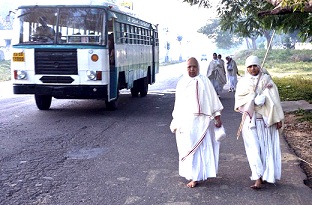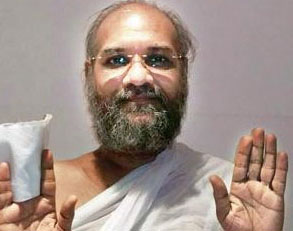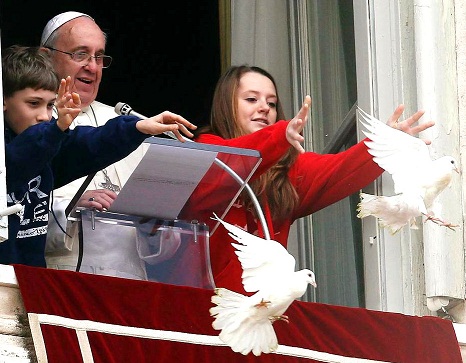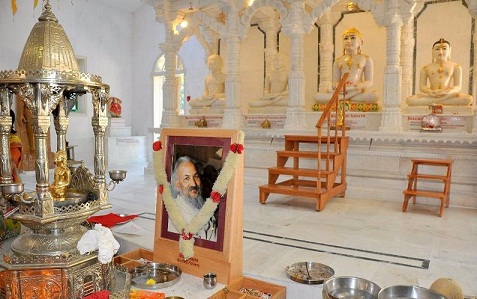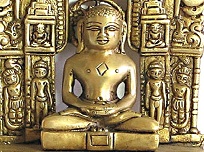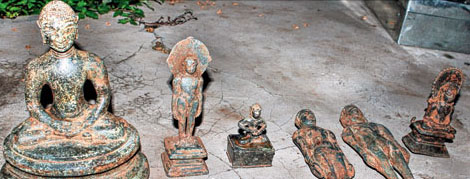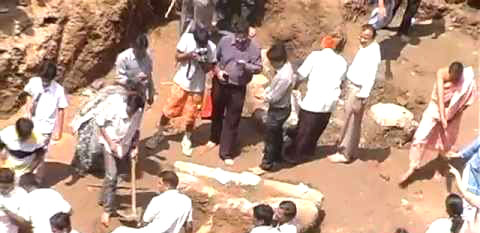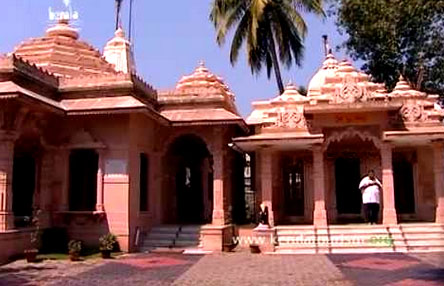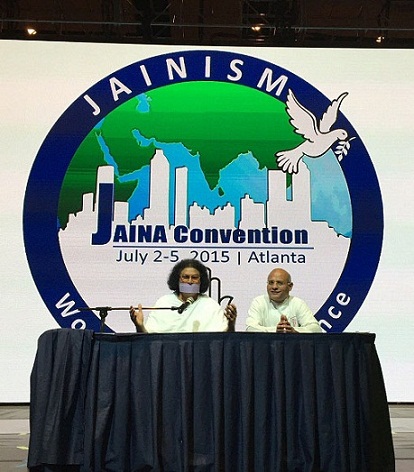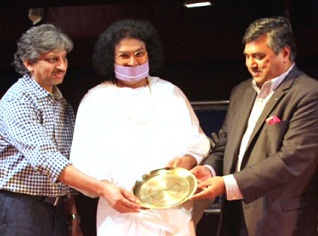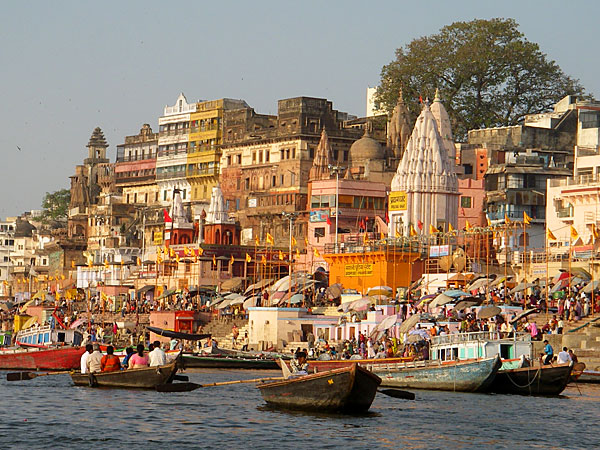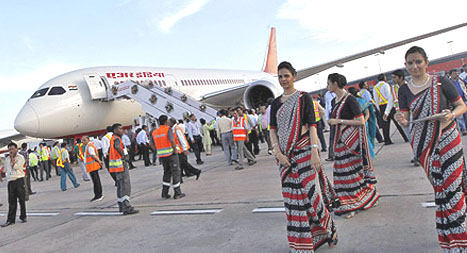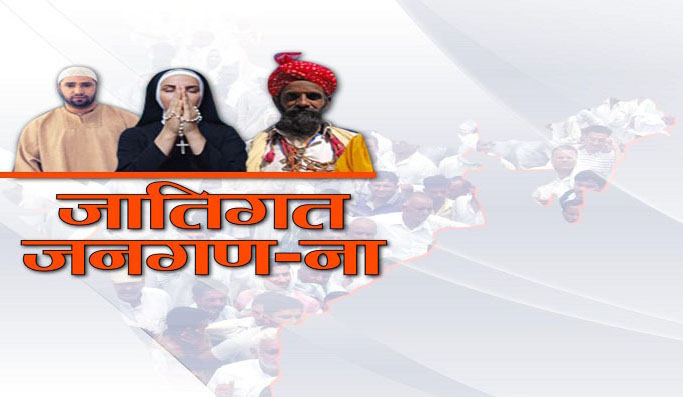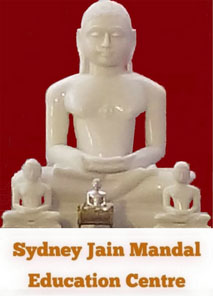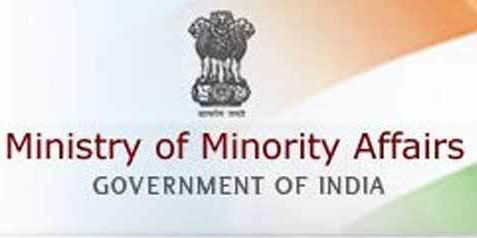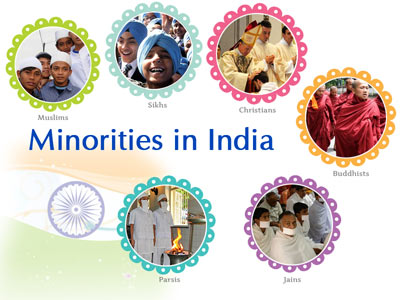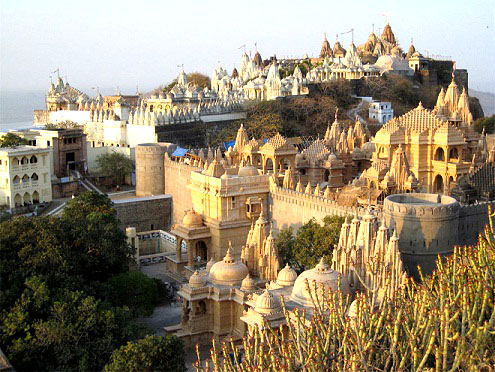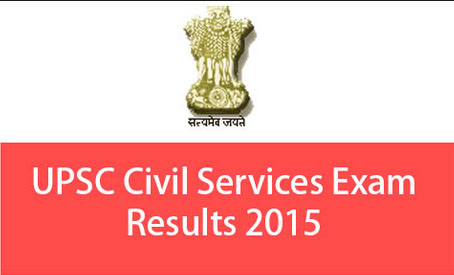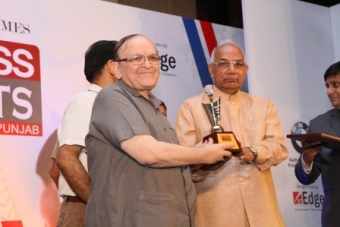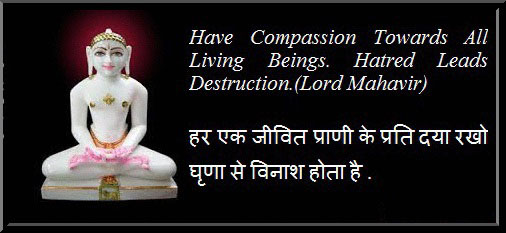
JAIN SAINTS
REPRESENTATION TO GOVERNMENT FOR SAFE MOVEMENT OF JAIN SAINTS
Shri Raj Nath Singhji
Hon’ble Union Minister of Home
New Delhi
Respected Sir,
With holy blessing of Digamber Jain Saint Param Pujya Acharya Shri 108 Gyansagar ji Muniraj, please find enclosed herewith the Representation of Vishwa Jain Sangathan to issue an order to all state Governments & UTs and Home Department for safe movement of holy Jain Saints and non-filing of FIR / not taking cognizance on the complaints made against Digamber Saints in all States / UTs of India.
|
Vishwa Jain Sangathan has taken a serious view of the fact that several attempts have been made recently to kill Jain Saints and Sadhvi in road accidents and Goa Court has issued an order to file FIR against Digamber Jain Saint due to attend a religious function in Margaon, Goa.
Under the present circumstances this representation is very much required and secondly we have no option except to approach you for taking immediate action & direction in this regard being controlling and supervising authority on the whole competent authorities of prosecution all over India. The Jain community of India looks forward for your gracious support to issue necessary directions to protect holy Jain Saints. We therefore request you kindly do the needful on the captioned subject at your earliest as the safety of our holy saints is the supreme law / the ultimate goal of all laws. Sir, Vishwa Jain Sangathan has a genuine & bona fide interest for the safety of holy Jain Saints in the above matter. Sanjay Kumar Jain, President, Vishwa Jain Sangathan, E-Mail:
HEMCHANDRA SURISHWARJI MAHARAJ CAUTIONS OTHER SAINTS FOR FOOD PREFERENCES
June 18th, 2015, Jain Sadhu Hemchandra Surishwarji Maharaj is advising his followers to avoid eating Naan, Kulchas and Rumali Rotis over concerns that vegetarian restaurants might be using eggs to increase the popular breads' softness and texture.
|
The spiritual gurus are urging community members to stick to the Plain Roti if they want to sincerely follow the core Jain Principle of Ahimsa. According to Hemchandra Surishwarji Maharaj "The Plain Roti is the best choice."
Hemchandra Maharaj has forwarded messages on the issue to more than 500 followers. Similar chain messages and mails by other leaders are also being circulated in the community.
Concerns over Naan, Kulchas and Rumali Rotis were first raised in the community two months ago when a member circulated a message claiming that even vegetarian restaurants use eggs to prepare the breads. The member said that a chef had revealed the practice to him. "I then made enquiries and found that the member's suspicion was not unfounded. I started telling my followers to avoid restaurants.
If that is not possible, then they should avoid ordering Naan, Kulcha and Rumali roti, " Hemchandra Maharaj said. Vijayratna Sundar Surishwarji Maharaj, a sadhu for the past 49 years, said that community members had been asked to be cautious as there were considerable doubts over the practices followed by different restaurants.
POPE FRANCIS’S ADVOCATES ANIMAL PROTECTION
The Vatican released Pope Francis’s new encyclical on the environment, and it is truly historic. The encyclical from the Pope is full of references to animals and calls on all of us to embrace a more humane path. The encyclical is named “Praised Be” after St. Francis of Assisi’s Canticle of the Sun, in which the Saint praises God for animals and creation. In the encyclical, the Pope reminds us, “We read in the Gospel that Jesus says of the birds of the air that ‘not one of them is forgotten before God’ (Lk 12:6). How then can we possibly mistreat them or cause them harm?”
|
The Pope also calls on us all to be better stewards of all creation, noting that “each organism, as a creature of God, is good and admirable in itself.” He condemns the view that humankind has “absolute domination over other creatures” as a misinterpretation of God’s grant of “dominion” over creation.
The Pope notes that “our indifference or cruelty towards fellow creatures of this world sooner or later affects the treatment we mete out to other human beings. We have only one heart, and the same wretchedness which leads us to mistreat an animal will not be long in showing itself in our relationships with other people. Every act of cruelty towards any creature is ‘contrary to human dignity’. ”And the Pope directly addresses animal testing, noting “the Catechism of the Catholic Church teaches that experimentation on animals is morally acceptable only if it remains within reasonable limits [and] contributes to caring for or saving human lives… human power has limits and that it is contrary to human dignity to cause animals to suffer or die needlessly. ”I asked Dr. Charles Camosy, Professor of Theological and Social Ethics at Fordham University and author of For Love of Animals, for insight into the significance of this encyclical. Here are some excerpts from our conversation: What moral limits should we consider placing on the market and technology to protect people, creation, and animals? Should price and efficiency continue to drive animal agriculture?
History shows us that, without protections, an unrestrained market will ignore and even reward the violent marginalization of inconvenient populations. Both human and non-human. In the new encyclical, Pope Francis shows how this is especially true when market forces are married to the imperative to use technology to do things cheaper and faster regardless of moral cost. The Pope calls us to resist an amoral rush to consume via technology in an unrestrained market. This disconnects us not only from the proper value of the things we consume and of the people who work to bring those goods to us but ultimately it disconnects us from ourselves. Consumerism is a soul-crushing practice, designed specifically to leave us unsatisfied so we keep on consuming more and more with no end in sight. While this might benefit the stock prices of big corporations, it kills the human spirit and, significantly, the wider creation. As Pope Francis says in the encyclical: the ecological crisis is primarily a spiritual crisis. We not only need new laws … we need to become different kinds of people, living our lives is fundamentally different ways. Ways which resist the quick and easy path of consumerism.
What current practices involving animals are inconsistent with the Pope’s vision of our relationship with creation and animals?
In his Apostolic Exhortation, The Joy of the Gospel Pope, Francis almost certainly invokes the plight of animals in factory farms when he speaks of “other weak and defenceless beings who are frequently at the mercy of economic interests or indiscriminate exploitation.” In such farms, technology is used to gain more protein units per square foot, thus making more money for the corporation and cheaper food for the consumer. But this is precisely the kind of consumerist social structure called out more generally in Laudato Si. Indeed, the new encyclical calls for a new kind of “asceticism”: one which cultivates new practices of resistance to “greed and compulsion” and instead seeing creation as something more than merely a set of objects to be “used and controlled.” Indeed, this is based on the theological idea taught by both John Paul II and Benedict XVI that all creation has intrinsic value. Here are some important quotes from Francis making this point:
“It is not enough, however, to think of different species merely as potential ‘resources’ to be exploited, while overlooking the fact that they have value in themselves.” (#33)
“Where certain species are destroyed or seriously harmed, the values involved are incalculable.” (#36)
“We must forcefully reject the notion that our being created in God’s image and given dominion over the earth justifies absolute domination over other creatures.” (#67)
Creation has “an intrinsic value” which is “independent of [its] usefulness. Each organism, as a creature of God, is good and admirable in itself.” (#140)
If we take the Pope seriously on this idea, Western culture in particular will need to totally rethink its relationship with animals as mere tools or products for us to use in sinful social structures of technological consumerism.
How is the flourishing of animals and creation related to the flourishing of human beings?
Perhaps the central new insight of Laudato Si is something that the Pope calls “integral ecology.” For decades now we’ve heard about the ecology of the non-human, and more recently Catholic theology has spoken of something called “human ecology.” But this new encyclical asks us to think about the interrelated ecology of the human and non-human.
Factory farms, of course, are a classic example of this. The intense and horrific harm done to animals is obvious. But the human harms are terrible as well: too much animal fat in our blood causing heart disease and cancer; all kinds of chemicals and drugs necessary for animals in factory farms getting transferred to human bodies; creation of dangerous superbugs via huge amounts of antibiotics; perhaps the most serious cause of climate change; and much more.
Pope Francis’ integral ecology explicitly “takes us to the heart of what it is be human.” (#11): When we reject consumerism, selfishness, and violence with respect to the non-human, we are then on the way to becoming the kinds of human beings we were created to be. In helping all of creation become happier and healthier, we become healthier and happier ourselves. This is the near-unbelievable good news the Gospel of the Christian message more generally. Rightly understood, Christian moral requirements are not a burden, but rather a means for becoming our best and most flourishing selves.
JAIN TEMPLES
SIDDHACHALAM TO CONDUCT SHILANYAS CEREMONY OF SHRI BHOMIYAJI MAHARAJ TEMPLE
|
Shri Bhomiyaji Maharaj has a very auspicious place among Jain deities. He is the protector of Jain religious places and the pilgrims and, as the Adhishthayak, guards Shri Sammet Shikharji, the most sacred Tirth for Jains. A replica of Shikharji is already created at Siddhachalam and now steps to enshrine Bhomiyaji Maharaj at Siddhachalam.
The Shilanyas Ceremony will be conducted from August 7th to 9th, 2015. Invitations for the ceremony are widely circulated. Many of the religious and spiritual leaders will also grace the occasion. The list includes, HH Acharya Roop Chandji Maharaj, HH Amarendra Muniji, HH Bhattarak Charu Keertiji, Samani Suyasnidhiji and Samani Shruthnidhiji.
All pujas will be conducted by renowned Vidhikaar Shri Narendra Nandu, Shri Mool Chand Gala, Shri Chandrasen and Siddhachalam Pujari, Shri Shravan Joshi.
The 3-day program will include a varghoda and multiple pujas. Donations for temple are requested. For further details, please contact us at (908) 362-9793, E-Mail: . Source: Kul Bhushan Jain, President, Siddhachalam Board of Trustees and Working Committee.
STOLEN 'ASHTADHATU' IDOLS OF MAHAVIRA RECOVERED
|
June 27, 2015; The police arrested one person and recovered three 'ashtadhatu' (made of eight metals) idols of Lord Mahavira stolen from a Jain temple in Kishanganj district of Bihar. Kishanganj Superintendent of Police said the idols were stolen in May from Jain Digambar Temple at Thakurganj in the district.
The Jain community was on relay hunger strike since then to press for their recovery. The police had been investigating the case and conducting raids for the recovery.
The idols are around 150 year old and are considered invaluable. Their disappearance had created a sensation in the area. Darbhanga zonal Inspector General had himself visited the temple and supervised the investigations.
TRIBALS DIG UP RARE JAIN IDOLS AT RAYAGADA
July 7th,2015, Bhubaneshwar: Chance finding of six rare Jain idols, perceived to belong to the period between 6th and 12th century AD, from Biripada village near Muniguda in Rayagada district will add to the rich collection of the Odisha State Museum. The metal idols were discovered from an ancient well-like structure barely 300 metres away from the course of the Bansadhara river near Munigada, which is nearly 385km from Bhubaneshwar.
|
The idols were found on June 25 when local tribals were digging the place for edible roots. Speaking on the find, culture and tourism secretary Arvind Padhee said: "After getting information on the rare idols, I had deputed a team of officials and archaeologist to Biripada and they are back with the idols. We will consult various experts in the field of archaeology to ascertain their antiquity and then hand them over to the state museum so that people can see them.''
Based on their structural pattern and design, officials and archaeologists of the state archaeology hinted that the rare metal idols might belong to the 10th or 12th century AD. Pointing at the peculiar bricks recovered from the site, Patnaik said: "With the size and pattern of the brick resemble those found in the post-Gupta period, we may conclude that the statues also belong to the same era or the 6th or 7th century AD. The post-Gupta rulers used to encourage religious beliefs of all kind.''
Regarding findings of Jain relics in forest patches, he said: "Such occurrence is a common sight in many parts of Odisha and Chhattisgarh as Jain religious leaders used to lead an austere life and always lived away from the crowd.'' While three metal statues are in sitting posture (mudra), three others are in standing pose.
Odisha had rich Jain relics and monuments in undivided Koraput district (now split into Rayagada, Nabarangpur, Malkangiri and Koraput), Mayurbhanj, Keonjhar, Angul, Ganjam, Puri, Jagatsinghpur, Bhadrak and Balasore districts. In the Koraput region, Jain sites are at Nandapur, Bhairab-Singhpur, Subei, Kotpada, Jamunda, Kamta, Jeypore, Boriguma and Remula. Jain history shows that its relics and monuments were seen along all ancient trade routes passing through the state. A new survey will serve the twin purposes of knowing more about the routes and Jain artifacts.
JAIN TEMPLE OF GANGA PERIOD EXCAVATED
|
Bharathingar, June 5th, 2015: A Jain Basadi, built during Ganga dynasty in the sixth century, has been excavated near Arethippuru village, Maddur taluk, Mandya district, Karnataka. In the month of September and October, a team of more than 30 had taken up the excavation works.
A Jain temple, measuring about hundred feet in length and 40 feet in width was discovered, along with seven statues atop Chandragiri Hill. The Jain temple consists of a facade, an entrance and sanctum sanctorum.
Ten stone pillars, statues of Bahubali, Yaksha and Yakshini, have been excavated. Apart from them, several other relics that were used to perform rituals at the temple were also discovered during the excavation. Experts opine that the Basadi was dedicated to one of the Thirtankaras of Jainism and was once a popular place for pilgrims, along with the temples at Shravanabelagola.
THIEVES TAKE AWAY ANTIQUATED IDOL FROM DHAR ROAD (INDORE) JAIN TEMPLE
July 9th, 2015, Indore: Unidentified thieves struck at Jain temple at Dhar Road and took away an idol, which was hundreds of years old, and other valuables. Police have registered a case and are probing the matter. The incident took place at Jayant Dham at Dhar Road late on night. Watchman told police that he went for sleep at around 2 am after which thieves barged into the temple after breaking locks and took away an idol which was many year old and weighted 3 kg. The theft was discovered in morning when watchman woke up. He immediately informed to priest about the incident.
NEW JAIN TEMPLE ADDS TO KOCHI'S ICONIC STRUCTURES
June 14th, 2015, Kochi: A Jain temple, resembling the famous ones on Mount Abu in Rajasthan, is nearing completion in the heart of Kochi along the quiet Srinivasa Mallan Road, just 50m from MG Road.
|
The construction of the temple, devoted to the 12th Tirthankar Vasupujya Swami, began in 2007 and has already attracted attention for its ornamental detail and minutely-carved ceilings, doorways and pillars.
Sources said no rust-prone metal, soil or cement were used to construct the 2,000 sq ft temple for which 560 tonnes of marble were brought from Rajasthan. The two other components used were silver and gold. Around 90% of the works are over and the remaining will be done before Paryushan, the in September.
"Acharya Ravi Shekhar Marasaheb visited Kochi early in 2000 and advised us to build a temple without using any material that would rust or has element of life in it, like soil. Kochi being a reclaimed city, it was difficult to construct a strong foundation. We used brass, placed huge stone pillar blocks on it and filled the gaps using powdered stone.
The temple was opened in 2011.The temple has a carving depicting Mount Shatrunjaya in Gujarat and the Panch Kalyanak, the complete portal on Jainism.100 families pray at the temple every day. Earlier, families here prayed at a home situated on the same plot or the Mattancherry Jain Temple on special occasions. There are around 700 Jain families in and around Kochi.
JAIN MEMORIAL BEING PLANNED AT KONAKONDLA
July 7th, 2015, With the State government refusing to spend any funds on researching further into the Jain inscriptions at Konakondla, Bharat Varsheeya Digambara Jain Thirthakshetra Committee (BVDJTC) has come forward to develop the same spending crores of rupees. A congregation of over a hundred people belonging to the Jain community at the village in the Vajrakaruru Mandal of the district has decided to build a memorial in the name of Acharya Kondakunda besides the construction of a residential Vidyapeeth (a place of learning) to teach, research and propagate his teachings. Mr. R. V. Chakravarthi, credited with finding out these Jain religious places almost five decades ago in Konakondla, said that Acharya Kondakunda, who wrote the Jain religious texts Pachastikayasara, Pravachanasara, Samayasara, Niyamasara and Barasanuvekkha was also the author of the famous Tamil treatise ‘Tirukkural’, otherwise known to be written by famous Tamil poet Thiruvalluvar.
CONFERENCES AND SEMINARS
VIOLENCE AND TERRORISM CANNOT SOLVE ANY PROBLEM: LOKESH MUNI
July 5th, 2015, Washington. Emphasising that war, violence and terrorism cannot solve any problem, a Jain Saint Dr. Lokesh Muni said in his address to the convention of Jains Association of North America (JAINA) in Atlanta that dialogue based on non-violence and unity in diversity can solve all conflicts. "Violence gives rise to counter violence. Dialogue based on Bhagwan Mahavir philosophy of non-violence and Unity in Diversity can solve all conflicts.
|
It is expected that like America we should develop unity between all four sects of Jainism to bring them under one banner, one flag and one roof and present the Jain religion and principals to the next generation in a scientific way".
Appreciating the extensive discussion held on ‘Jainism: World of Non Violence’ held during JAINA Convention 2015 he said that the discussion is held at a time when on one hand natural disaster caused by earthquake in Nepal has moved the world and on the other hand war, violence and terrorism caused due to communal and racial frenzy in different parts of the world is terrifying the humanity.
On the occasion Acharya Chandnaji, Acharya Roopchandji, Acharya Amrendra Muniji, Manak Muni Ji, Saman Srutpragyji, Samani Parimal Pragyaji, Samni Dr. Suyash Nidhiji, Bhattarak Charukirtiji, Guru Chandrasenji also addressed the gathering. President of JAINA Shri Prem Jain, Convener of Convention Shri Damodia, and President of Atlanta Jainn Sangh Shri Samir Bhai Shah expressed their views on the occasion. The program was hosted by Chicago Jain Center.
The four-day 18th biennial JAINA convention beginning July 2 was attended by over 4000 representatives from 70 Jain centers in North America and several Jain religious leaders and community members from 22 countries including India. It also included 47 Sadhu-Sadhvi, Saman-Samani and religious preachers.
He said that working through its 69 Centres in North America JAINA has been successfully working to strengthen Jain Community and doing humanitarian works due to which its voice is heard in United Nations and White House. He said that even after living in western countries with extreme materialistic development and having a very busy lifestyle they are working towards conserving religious, social, spiritual and cultural values.
ACHARYA LOKESH MUNI JOINS INTERNATIONAL YOGA DAY CELEBRATIONS AT NEW YORK
|
Acharya Lokesh Muni addressing the International Yoga Day Event organised by Celebrations Inc. and Vedic Heritage Inc. at Vedic Heritage Hanuman Temple, New York on the eve of International Day of Yoga said that many global problems can be solved by introducing Yoga in education system.
He emphasized that by introducing Yoga right from the beginning in our education system best individuals, society and world can be formed. Yoga should be part of lifestyle for complete and balanced development. Acharya Lokesh talking about Jain Yoga said that from Bhagwan Rishabh to Bhagwan Mahavir idols of all are there in Yoga Mudra. Indian scholar Shri Vir Chand Raghavji Gandhi promoted Yoga in America long back.
Momukshu Parmanand expressing his views on the occasion dedicated himself to Spiritual World and It is noteworthy that Momukshu Parmanand has taken education from Harvard University, Boston and has been practicing as Doctor in New York from last several years. Acharya Lokesh gave him blessings for successful Spiritual Life.
MISCELLANEOUS
UP GOVERNMENT TO BACK FIRST JAIN CIRCUIT IN VARANASI
Jul 13, 2015, Varanasi: State tourism minister Om Prakash Singh has announced State Government's support in developing the first-ever Jain circuit in Varanasi. He said that Chief Minister Akhilesh Yadav would soon sign a Memorandum of Understanding for development of a Jain circuit in Varanasi on Public Private Partnership Model with a trust.
|
Speaking at a function hosted by Sri Jain Shwetambar Tirth Society at Jain temple, Bhelupur, Singh reiterated State Government's commitment towards promoting tourism in the city. Appreciating Sri Jain Shwetambar Teerth Society's idea of developing a Jain circuit, he assured of all assistance.
Singh further said that officials concerned had been instructed about declaring Chandrawati at Chaubeypur as Jain Teerth, development of main entrance of Chandrawati - Hiramanpur village by repairing arterial road and naming the terrain of Chandrawati Teerth temple for complete development of Jain circuit.
Trustee of Seth Anandji Kalyanji Pedhi Trust Ahmedabad-resident Pal Bhai Shah opined that development of Jain circuit would not only promote tourism but also garner investments. As per trust's estimate, the project would cost around Rs 500 crore. Planner India, a company of architects associated with project, Chairman Shyam Lal Singh provided detailed information about the work plan and said that UP government had offered a financial assistance of Rs 25 crore for developing a ghat at Chadrawati on city outskirts. Chadrawati is the birthplace of Chandraprabha, the Eighth Tirthankara of Jain community. The Jain circuit would have both road and river routes traversing through Ganga, he added.
The Jain circuit at Sarnath, one of the most revered place for Buddhists and also one of the key tourism sites, is going to be developed on PPP model on the initiative of Sri Jain Shwetambar Tirth Society (SJSTS) which would coordinate development projects in the circuit. Seth Anandji Kalyanji Trust of Ahmedabad, Gujarat, would develop the Jain circuit in the ancient temple town and its adjoining areas. The trust would offer financial assistance of around Rs. 500 crore. In UP, the circuit would cover Varanasi, Kaushambi, Shravasti and Kushinagar.
AIR INDIA IN CONTROVERSY FOR SERVING NON-VEG MEAL TO JAINS
|
July 1st, 2015: The series of controversies surrounding Air India never seem to die. From pilots fighting in the cockpit to finding a lizard in a biryani, Air India has made headlines for all the wrong reasons.
And it seems to have done it again when the airline's cabin crew served meat to some Jain pilgrims on a on Leh-Delhi flight returning from Sindhu Darshan festival.
The incident occurred on an Air India chartered flight which took off from Leh airport when many passengers belonging to the Jain religious community objected to non-vegetarian food packets being served to them for lunch, despite prior selection of a special "Hindu meal".
The national carrier has reportedly suspended the two catering staff members of the basis of complaint filed by passengers.
SOUTH AFRICAN HINDUS SEEK DIWALI AS PUBLIC HOLIDAY
Hindus are urging South Africa to include Diwali, the most popular Hindu holy day, as a Public Holiday.Currently South Africa has 12 public holidays (New Year's Day, Human Rights Day, Good Friday, Family Day, Freedom Day, Workers' Day, Youth Day, National Women's Day, Heritage Day, Day of Reconciliation, Christmas Day, Day of Goodwill).
|
Hindu statesman Rajan Zed, in a statement in Nevada (USA), said that it was not fair with the South African Hindu community as they had to be at work / school on their most popular festival while there were public holidays on other religious days.
Zed, who is President of Universal Society of Hinduism, stressed that South African Government needed to revisit its public holiday policies as sizable number of its citizens were Hindus, who had made lot of contributions to the country. It was important to meet the religious and spiritual needs of South African Hindu families, Zed added. Diwali, the festival of lights, aims at dispelling the darkness and lighting up the lives and symbolizes the victory of good over evil. Besides Hindus, Sikhs and Jains and some Buddhists also celebrate Diwali, which falls on November 11 in 2015. Hinduism, oldest and third largest religion of the world, has about one billion adherents and moksh (liberation) is its ultimate goal.
Rajan Zed stated that it was paramount for Hindu families to celebrate Diwali day together at home/temple. Public holiday on Diwali would ensure that and it would be a step in the positive direction.
INDIAN CABINET PUTS CENSUS CASTE DATA ON HOLD
An official Government spokesman, however, said no use releasing the raw data as it has thrown up as many as 46 lakh castes and sub-castes, with all sorts of synonyms, surnames, gotras and clan names.Keeping in view its political consequence, the finds of the caste census conducted by the Central Government between 2011 and 2014 will remain under wraps. As the demand for its release gets shriller ahead of the Bihar assembly elections, Union Cabinet meeting chaired by Prime Minister Narendra Modi constituted an expert group to be headed by NITI Aayog Vice-Chairman to further study and analyse the census. The cabinet also empowered the Social Justice and Tribal Welfare Ministries to service it and nominate other members of the group.
|
Bihar chief minister Nitish Kumar had questioned the Centre in a NITI Aayog meeting for releasing only partial data relating to the economic status of the rural India and not the caste data crucial in the matter of the future reservation to the OBCs (other backward classes). Rashtriya Janata Dal chief Lalu Prasad organised a march in Patna early this week to protest at the government not releasing the caste data. Congress also demanded release of full data, as current reservation policy was still based on 1931 caste census.
The caste data would have revealed actual number of Other Backward Classes (OBCs) put at 54% of India's population, based on the 1931Census figures used by the Mandal Commission, resulting in granting of 27% reservation to them. However, a careful analysis of the released data suggests the OBC population making upto 66.48% out of the total 17.92 crore rural households. The SECC survey has put the overall population of Scheduled Castes at 18.46% and Scheduled Tribes 10.97%. The rest are clubbed under the head "other households" numbering 12.27 crore which works out to 68.52%. It puts 2.04% of these in the category of "no caste & tribe households. If deducted from the "other households," it gives a percentage of 66.48%. Overall the SC/ST households have been put at 21.53% of the rural population.
In 2010 when the UPA government decided to conduct the caste survey, it was fiercely opposed by the Rashtriya Swayamsewak Sangh (RSS). But those in favour of such a census say it was necessary to find actual figures of castes as far as caste-based reservations are in vogue in the country. The 1931 census, used by the Mandal Commission, Upper Castes comprise 15% of total population. But had 66% representation in politics, 87% in services, 94% in trade and 92% of them as land owners. The rest 85% of population had just 13% share in services, 6% in trade and 8% were land owners.
JAIN FAMILY CLOSES 225 YEARS OLD "GHANTEWALA" SWEET SHOP
|
Ghantewala, a 225-year-old landmark sweet shop in Old Delhi’s Chandni Chowk, downed its shutters recently, breaking many a sweet-lovers’ heart and signalling how the changing environs of the Delhi's Walled City claimed another piece of the Capital’s heritage.
The shop folded up today after 225 years. The sweet shop was known across Delhi and outside for its pure desi ghee sweets. Located near Paranthe Wali Gali on the main Chandni Chowk street, Ghantewala (Sohan Halwa Shop) had been in the business since 1790. Lala Sukh Ram Jain had started selling sweets after arriving in Shahjahanabad from Amer in Rajasthan. Several stories have passed down the generations on why he came to be known as Ghantewala. It is said that Lal Sukhram Jain didn’t have a shop back then.
He sold sweets on a push cart. It is said that he rang the bell when he arrived on the street. The first shop was located near Fountain Chowk. The family later split and an outlet was started on the main street. Present Ghantewala Shop was being run by Sushant Jain, a seventh generation descendant. Mughal emperor Shah Alam would often send his servants to get sweets from the halwai parked near a bell hanging down through a thick chain. Ghantewala has had the Nehru family as its patron too. It was a popular landmark in the heritage walks.
JAIN STUDIES
SCHOLARSHIP FOR JAIN STUDIES IN 2015
15 July 2015, Courtsy B.C. Mehta Trust, SOAS is offering one Jaina Studies Scholarship. The scholarship is for a first year MPhil / PhD in the Study of Religions with a research proposal on Jaina Studies. The candidate must be a new admission (starting in September 2015).
|
The candidate must be eligible to pay the full time overseas tuition fee for 2015/16.
The total value of the scholarship for 2015/16 is £14,100 to be used for the first year tuition fee only. The Jaina Studies Scholarship is for one year. For further details log on www.soas.ac.uk, Source: Dr Peter Flügel, Chair, Centre of Jaina Studies, Department of the Study of Religions Faculty of Arts and Humanities, School of Oriental and African Studies, University of London. Thornhaugh Street, Russell Square, London WC1H OXG, E-Mail: ,www.soas.ac.uk/jainastudies
JAINISM ABROAD
JAINISM ABROAD NEW DEVELOPMENTS - AUSTRALIA
|
Sydney Jain Mandal has undertaken a project to build Jain Education Center / Jinalay in Sydney, Australia. The centre will be a focal point for promoting Jain principles and will provide a social platform to the Jain Diaspora in Australia. SJM will build and manage a Jain education center with support from its members in Sydney and communities members in other parts of Australia & overseas.
Sydney Jain Mandal has embarked on a long standing dream of Jains in Australia to build a Jain Education Center and Jinalay in Sydney. The center will be hub for teaching Jain principles for generations to come.
The centre will conduct regular classes on Jain principles and will provide venue for learning teachings of Jain religion. There will be practical classes about Jain rituals etc. The centre will also organise meditation and Yoga classes.
Towards this objective, SJM has already purchased a property at 7/15-17 Tucks Rd, Seven Hills, NSW 2147. Murti Pratishtha of Shri 1008 Bhagwan Mahaveer Swami idol was performed recently at this new location. Detailed information can be view at www.SydneyJainMandal.com SJM also solicits formality support in its endeavor to build the Jinalay / education centre.
SJMEC has got tax deductible status from Australian Tax office and all donations above $2.00 are tax deductible for the donors.
JAIN MINORITY STATUS
NOW SELF-ATTEST YOUR CERTIFICATES TO SEEK MINORITY BENEFITS
28th June 2015, New Delhi. Government has done away to the practice of issuing minority certificates. Minority community members can now self-attest the documents and respective government institutions are directed to accept the same, across all departments and educational institutes.
|
Therefore now, people belonging to minority communities will no longer have to secure certificates from officials to avail of benefits of welfare schemes, with the government making it clear that self-attestation was enough. "In this context, it is informed that minority certificate is not mandatory for getting the benefits of welfare schemes being implemented by the ministry," the Ministry of Minority Affairs has said in a recent communication to the states. The government has notified six communities as minorities - Muslims, Christians, Sikhs, Buddhists, Parsis and Jains.
The removal of requirement of minority certificates is in keeping with the government's decision to accept self-attestation across all departments and educational institutes. The development came after the ministry received several representations from people belonging to minority communities, especially Jains, complaining about not being able to avail of benefits extended to them in the absence of certificates testifying to their communities from the concerned state government authorities.
The ministry had last year done away with the requirement of submission of affidavits towards community certificate and income certificate under pre-matric, post-matric and merit-cum means based scholarship schemes for students belonging to the notified communities. It had stated that for community certificate, self certification by the student is sufficient. The decision also comes in wake of the ministry launching programmes for raising the socio-economic profile of the minorities.
MASTER CIRCULAR BY RBI ABOUT - CREDIT FACILITIES TO MINORITY COMMUNITIES
RBI has issued Master Circular for consolidating the instructions / guidelines / directives issued to banks till that date relating to Credit Facilities to Minority Communities. The Master Circular has been suitably updated by incorporating the instructions issued upto December 03, 2014 and has been placed on the RBI website www.rbi.org.in
Master Circular
|
1. Credit Facilities to Minority Communities - In terms of Reserve Bank's extant guidelines on lending to priority sector, a target of 40 per cent of Adjusted Net Bank Credit (ANBC) or Credit Equivalent amount of Off-Balance Sheet Exposures (OBE), whichever is higher, as on March 31 of the previous year, has been mandated for lending to the priority sector by domestic scheduled commercial banks and foreign banks with 20 and above branches. Within this, a sub-target of 10 per cent of ANBC or Credit Equivalent amount of OBE, whichever is higher, as on March 31 of the previous year, has been mandated for lending to weaker sections which includes, among others, persons from minority communities. The Government of India has indicated that care should be taken to see that minority communities secure, in a fair and adequate measure the benefits flowing from various Government sponsored schemes. All commercial banks, have been advised to ensure smooth flow of bank credit to minority communities.
2. Definition of Minority Communities - Sikhs, Muslims, Christians, Zoroastrians, Buddhists and Jains are notified as minority communities by the Government of India.
3. Creation of Special Cell and Designating an exclusive Officer - A Special Cell should be set up in each bank to ensure smooth flow of credit to minority communities and it should be headed by an officer holding the rank of Deputy General Manager / Assistant General Manager or any other similar rank who should function as a 'Nodal Officer'. Government of India has forwarded a list of 121 minority concentration districts having at least 25% minority population, excluding those States /UTs where minorities are in majority (J & K, Punjab, Meghalaya, Mizoram, Nagaland and Lakshadweep). Accordingly, all scheduled commercial banks are required to specially monitor the credit flow to minorities in these 121 districts, thereby, ensuring that the minority communities receive a fair and equitable portion of the credit within the overall target of the priority sector (list of Minority Concentration districts at Annexure II). The designated officer should exclusively look after aspects relating to credit assistance to minority communities in the concerned districts. The designated officer may be attached to the Lead Bank set up at the district level. He would thus, be able to receive necessary guidance from Lead Bank Officer, who will be senior enough and have adequate experience for liaising effectively with the other credit institutions and Government agencies, and will also be working in close collaboration with the branch managers of other banks in the district. The designated officer will also arrange group meetings for their guidance for formulation of schemes suitable for the members of the minority communities. It will be necessary for the banks concerned to ensure that the role assigned to the designated officer/s is effectively fulfilled.
The Convenor banks of the District Consultative Committees (DCCs) and the State Level Bankers Committees (SLBCs) should ensure that steps taken to facilitate the flow of credit to the minority communities and the progress made in this regard are reviewed regularly at their meetings. The Convenor banks of DLRC/SLRM/SLBCs may invite Chairman/ Managing Directors of State Minority Commissions/Boards or the State Minorities Financial Corporations or their representatives to attend the meetings of District Level Review Committee (DLRC), State Level Review Meeting (SLRM) and State Level Bankers Committee (SLBC). Names, designation and office addresses of (i) the officer-in-charge of the Special Cell at Head Office and (ii) officer appointed by Lead Banks in the identified districts to look after exclusively the problems of minority communities, should be furnished by banks to the National Commission for Minorities at the following address and updated periodically:
The Lead Banks in the identified districts having concentration of minority communities may involve the State Minority Commission / Finance Corporation in the extension work including creating awareness, identification of beneficiaries, preparation of viable projects, provision of backward and forward linkages such as supply of inputs/marketing, recovery etc. The Lead Banks in the identified districts may collaborate with DDMs of NABARD/ NGOs/ Voluntary Organizations in reaching the poor through Self Help Groups (SHGs). Lead Banks of the Minority Concentration Districts will have to exercise the pro-active role expected of them to ensure that the minority communities, particularly those who are poor and illiterate have access to bank credit for taking up productive activities.
4. Advances under DRI Scheme - Banks may route loans under the DRI scheme through State Minority Finance/Development Corporation on the same terms and conditions as are applicable to loans routed through SC/ST Development Corporations, subject to the beneficiaries of the Corporations meeting the eligibility criteria and other terms and conditions prescribed under the scheme. Banks may ensure proper maintenance of the register to evolve timely sanction and disbursement of loan applications.
5. Monitoring - Banks may route loans under the DRI scheme through State Minority Finance/Development Corporation on the same terms and conditions as are applicable to loans routed through SC/ST Development Corporations, subject to the beneficiaries of the Corporations meeting the eligibility criteria and other terms and conditions prescribed under the scheme. Banks may ensure proper maintenance of the register to evolve timely sanction and disbursement of loan applications. The statements (given in Annexure I) should reach RBl within one month from the close of each half-year. In the case of a partnership firm, if the majority of the partners belong to one or the other of the specified minority communities, advances granted to such partnership firms may be treated as advances granted to minority communities and accordingly included in the prescribed statement. A company has a separate legal entity and hence advances granted to it cannot be classified as advances to the specified minority communities.
The Convenor banks of the District Consultative Committees in the identified districts should furnish the data on priority sector advances granted by banks to specified minority communities compiled by them in the prescribed format (vide Annexure III) for the district under their lead responsibility to the concerned Regional Offices of RBl within one month from the close of the relative quarter. The progress made in regard to the flow of credit to the minority communities should be reviewed regularly at the meetings of the District Consultative Committees (DCCs) and the State Level Bankers Committees (SLBCs). The Lead Banks in the identified districts should furnish the relevant extracts of the agenda notes and the minutes of the meetings of the DCCs and of the respective SLBCs to the Union Ministry of Finance and to the Ministry of Welfare on a quarterly basis for their use.
6. Training - With a view to ensuring that the bank staff and officers have proper perspective and appreciation of the various programmes for welfare of minorities, necessary orientation may be provided to officials and other staff. For this purpose, banks should include suitable lecture sessions as part of all relevant training programmes like induction courses, programmes on rural lending, financing of priority sectors, poverty alleviation programmes, etc. The Lead Banks functioning in the identified districts should organize Entrepreneur Development Programmes so that the members of the minority communities in these areas are enabled to derive the benefit of various programmes being financed by the banks. Depending upon the major vocation and type of activity undertaken by large sections of the people in the districts, suitable programmes may be organized in co-operation with State Governments, Industries Department, District Industries Centre, SIDBI, State Technical Consultancy Organization, Khadi and Village Industries Commission and other voluntary organizations which are fully equipped to impart such training and orientation. The duration of the programme, the course content, the faculty support to be selected etc. should be decided by each Lead Bank taking into account the prevailing conditions, need and existing skills as well as aptitude of the people in the district.
The Lead Banks in the identified districts may sensitise and motivate the staff posted to identified districts through proper training to assist the minority communities under various credit schemes. The Lead Banks may organize sensitization workshops for bank officials regarding micro credit/ lending to SHGs with the help of DDMs of NABARD.
7. Publicity - There should be good publicity about various anti-poverty programmes of the Government where there is large concentration of minority communities and particularly in the districts listed in the Annexure II which have a concentration of minority communities. The Lead Banks in the identified districts may create awareness among minority communities regarding credit facilities available from banks through appropriate measures which may include publicity through (i) print media i.e. distribution of pamphlets in local languages, advertisements/articles in newspapers etc. (ii) TV channels - DD/ local channels, (iii) participation / setting up of stalls in the Melas / fairs organized during the religious /festive occasions by these communities.
8. National Minorities Development and Finance Corporation (NMDFC) - National Minorities Development and Finance Corporation (NMDFC) was established in September 1994 to promote economic and developmental activities for the backward sections amongst the minorities. NMDFC works as an apex body and channelises its funds to the beneficiaries through the State Minority Finance Corporation of the respective State/Union Territory Governments. The NMDFC is operating, inter-alia, the Margin Money Scheme. Bank finance under the scheme will be upto 60 percent of the project cost. The remaining amount of the project cost is shared by NMDFC, the State channelising agency and the beneficiary in the proportion of 25%, 10%, and 5%, respectively. Banks may implement the Margin Money scheme evolved by NMDFC. While extending bank finance, banks should bear in mind the guidelines/instructions issued by RBI from time to time on priority sector advances. It may be ensured that the assets created out of the loan amount are mortgaged / hypothecated to the banks. Where recoveries have been made by the banks, it would be in order if the amounts are appropriated first towards bank dues.
9. Prime Minister’s 15 Point Programme for the Welfare of Minorities - Government of India has revised the “Prime Minister’s New 15-Point Programme for the Welfare of Minorities”. An important objective of the Programme is to ensure that an appropriate percentage of the priority sector lending is targeted for the minority communities and that the benefits of various government sponsored schemes reach the under-privileged, which includes the disadvantaged sections of the minority communities. The New Programme is to be implemented by the Central Ministries/Departments concerned through State Governments/Union Territories and envisages location of certain proportion of development projects in minority concentration districts. Accordingly, all scheduled commercial banks are required to ensure that within the overall target for priority sector lending and the sub-target of 10 percent for the weaker sections, sufficient care is taken to ensure that minority communities also receive an equitable portion of the credit. Lead Banks have been advised to keep this requirement in view while preparing district credit plans.
JAINS IN GUJARAT MAY GET MINORITY STATUS SHORTLY
July 1st, 2015, Ahmedabad: According to Social Justice and Empowerment Minister, Ramanlal Vora, Jain community members living in Gujarat are set to get the minority status shortly. “The earlier Central government had given the minority status to Jains. Now, the state government has initiated the process to notify Jain community as minority in Gujarat. We are taking this matter very positively and recently held a meeting in this regard,” the minister said.
|
“I believe that a positive decision in this regard will be taken by July-end,” he added. It is to be noted that local body elections are expected to be held in the state in October. Welcoming the move, Jain leaders have expressed happiness and claimed that the minority tag will help the community in preserving their culture.
“Jains do not need reservation. We wanted this status to preserve our culture and religion. Apart from getting scholarships meant for minorities, we can now reserve 50 per cent seats for our students in Jain institutions,” said Vimal Shah, city president of ‘Terapanth Professional Forum’ that has been demanding this status since long. “…Just like Madrasas (Muslim seminaries), Jain education institutions will not have government control (after getting the minority status), which will enable us to expand our horizons. Another major advantage is that our religious places will be free from any government interference, which will enable us to develop it as per our wish,” he said.
AHIMSA AND VEGETARIANISM
QUOTATIONS ABOUT AHIMSA AND VEGETARIANISM
According to Edward Martin, MD, Dept. of Defence Health Director (National Public Radio and CNN), the trans fatty acids (found in animal products and cooked oils) is a strong factor in breast cancer.
|
It's a very romantic notion, an entrenched part of American culture, but I've seen, for example, pigs waiting to be slaughtered, and their hysteria and panic was something I shall never forget.” - Cloris Leachman, actress.
“In fact, if one person is unkind to an animal it is considered to be cruelty, but where a lot of people are unkind to animals, especially in the name of commerce, the cruelty is condoned and, once large sums of money are at stake, will be defended to the last by otherwise intelligent people.” -Ruth Harrison, author.
“Truly man is the king of beasts, for his brutality exceeds them. We live by the death of others. We are burial places.” -Leonardo da Vinci.
“The awful cruelty and terror to which tens of thousands of animals killed for human food are subjected in traveling long distances by ship and rail and road to the slaughterhouses of the world. God disapproves of all cruelty... whether to man or beast. The occupation of slaughtering animals is brutalising to those who are required to do the work.... I believe this matter is well worthy of the serious consideration of Christian leaders.” -Mrs. Booth and General Bramwell Booth, daughter-in-law and son of the founder of the Salvation Army. “Behold I have given you herb yielding seed. To you it shall be for meat.”-Genesis l:29. Source: Giriraj Daga, E-Mail:
ADMINISTRATION YET TO CONFIRM - PALITANA IS MEAT-FREE ZONE
06 July 2014: For hundreds of years, followers of the Jain religion have been lured to the quiet town of Palitana. In the adjoining hills of Shatrunjaya are located countless sacred temples and it is said that every Jain should make a pilgrimage to them once in their life. But in recent weeks Palitana, located in the western Indian state of Gujarat, has become the site of an unlikely controversy after Jain monks launched a hunger strike threatening to fast unto death and demanding the town be declared a vegetarian zone. The monks say that non-vegetarian food in which they include eggs should not be permitted for sale or storage anywhere in Palitana. They have also called for a ban on the ritual slaughter of animals and want an estimated 260 butchers’ shops to be closed.
|
But local Muslims say the demands by the monks discriminate against them. Most Muslims eat meat and eggs as part of their diet and say it is essential they are able to offer sacrifice during specific religious holidays. The monks have for now called off their hunger strike following an assurance by local politicians and officials that the matter would be looked into promptly. But the controversy has not gone away and the monks have said they will restart the hunger strike if their demands are not met. “Every religion has its own sacred places, what you call holy cities or pilgrimage sites. Jains too, have a lot of sacred places, but Palitana is the most important,” Virag Sagar Maharaj, the monk who is leading the protests, told The Independent.
He claimed the founder of the Jain religion, Adinath, had visited Palitana millions of times and climbed into the hills. He added: “Now, with his divine presence here in Palitana and that of several other Jain saints, how do you expect us to tolerate violence in this city?” Officials say that Muslims are about 20-25 per cent of Palitana’s population of 65,000. Reports suggest that there are also considerable numbers of non-Muslims who would also like to eat meat if they were permitted to do so. Leaders of the local Muslim community have held their own meeting with officials to try and ensure meat-eating and slaughter of animals is not banned in Palitana.
Efforts by the Jain community to have Palitana declared hinsa-mukt, or violence-free, date back a number of years. They have even offered financial compensation to restaurants and food vendors who sell meat or eggs to change their trade. In 1999, local officials declared that a one-and-a-half mile stretch of road leading towards the temples should be made a vegetarian-only zone. Pravin Solanki, a government official, said the municipal authority was discussing whether to extend the zone.
AWARDS AND ACHIEVEMENTS
SHEKAR HATTANGADI HONOURED FOR PRODUCING DOCUMENTARY FILM ABOUT "SANTHARA"
Shekar Hattangadi's 25-minute documentary Santhara, on age-old practice of fasting unto death by members of the Jain community, won the award for the Best Script recently at the 4th Bangalore Short Films Festivals. Hattangadi (60) spent five years working on the film. He became interested in the subject during a classroom discussion at a law college in Mumbai where he was a guest faculty. He came across a news article about a PIL Nikhil Soni v Union of India filed about the practice of Santhara in Churu district in Rajasthan. Curious about the case he went to Churu and talked to the people about Santhara practice observed by Jains. Santhara or Sallekhana is an ancient Jain practice undertaking voluntary death.
|
According to the Producer Hattangadi, Jain community takes their religion far too seriously. Some orthodox Jains believe that even a bite into a fruit would lead to disturbing the ecology. The ultimate expression of non-violence for them is of course the practice of Santhara, which is to not drink or eat. During the course of my research I was surprised to learn that if you offer an orthodox Jain a mango or a strawberry, he/she would choose a mango because it has only one seed which means they would be denying only one life to spring again through that seed which gets wasted.
During my research, I met Nikhil Soni, a petitioner and lawyer at Jaipur, who told me that the ritual was nothing short of murder devised to rid the family of the economic burden of taking care of its aged and unproductive members. In Churu district, influential industrialists have ancestral Havelis where people from their extended family would live. Soni recalled the typical modus operandi exemplified in the Bimla Devi case. Diagnosed with terminal cancer, the elderly woman was too weak and depressed to protest as her relatives went about publicly announcing "her decision" to undertake Santhara. I was baffled beyond reason to learn that family members of the one undergoing Santhara would call the Bhajan Mandali members who would sing loudly accompanied by high decibel percussion to drown the cries of the dying person. This apparently happened in Bimla Devi's case when she began screaming in a last-ditch effort to get food and water.
Santhara in a way gave the family great recognition. The family members took great pride in it. For them it was a celebration. The son of Keila Devi Hirawat, a widow who chose to starve to death near Jaipur, told me how it was not "fasting to die, but a festival to face death". He believed that his mother was cleansing her soul. Earlier, nobody in the village would pay any attention to Hirawat's family. But after her Santhara, people would pause in front of her house to offer prayers. All this made the family very happy. Her daughter-in-law said: "Everyone in the family is very happy. After all, she has brought name and fame to our family."
The documentary explores the dimensions of the law-religion conflict by focusing on the spiritual, ethical, medico-legal and sociological aspects of the controversial Jain ritual of Santhara, in which a person gives up food and drink after taking a vow of abstinence, resulting in death by starvation. The film looks at how religion, law and constitutional secularism intersect in the ongoing debate over Santhara.
The Ritual Of Santhara Starts when a Jain feels that he / she has entered a stage in life, with nothing meaningful left to complete, he/she seeks permission from friends, family and guru to take up the practice of Santhara. Once permission is given, he/she gradually gives up food and liquids. 60-year-old monk Sadhvi Charan stayed alive for 87 days, the longest, after taking the oath of Santhara. 60% of Jains taking up Santhara are women. The practice is more popular with women, ill or dying. But healthy people both monks and ordinary people participate in the ritual. Source: www.odditycentral.com
CONGRATULATIONS TO JAIN CANDIDATES CLEARING UPSC, 2015 EXAMINATION
We look forward to see you as able and effective executives of Government of India and in service to nation as IAS, IPS, IRS, Collector, S.P. We are proud of you and wish you all the very best. Our heartiest congratulations to the parents of all these candidates.
| • Sanskriti Jain • Nishant Jain • Gargi Jain • Aashika Jain • Gautam Jain • Mudit Jain • Ekta Jain • Vipin Jain • Akshat Jain | • Arpit Jain |
INDIAN AMERICAN TEACHER FROM ILLINOIS DARSHAN JAIN AWARDED PRESIDENTIAL AWARD FOR EXCELLENCE IN MATHEMATICS AND SCIENCE TEACHING
July 2nd, 2015, Washington: Darshan Jain, an Indian American teacher from Illinois, has been appointed by President Barack Obama with the prestigious Presidential Award for Excellence in Mathematics and Science Teaching.
|
Darshan Jain, who serves as the Director of Mathematics at Stevenson High School in Lincolnshire, Illinois, is one of 108 mathematics and science teachers who were bestowed with the award and $10,000 each from the National Science Foundation.
“These teachers are shaping America`s success through their passion for math and science,” Obama said of the winners. “Their leadership and commitment empower our children to think critically and creatively about science, technology, engineering, and math.”
It’s not the first time Jain has received high acclaim for his teaching. In 2010, he was one of 10 Chicago-area teachers to receive the Golden Apple Award for Excellence in Teaching, according to the Daily Herald.
The Presidential Award for Excellence in Mathematics and Science Teaching is awarded annually to outstanding kindergarten through 12th grade science and mathematics teachers from across the nation. Darshan Jain has a B.A. in mechanical engineering and a M.S. in secondary mathematics education from the University of Illinois at Chicago. He is pursuing further graduate work. His experience in the field includes time as a project engineer and a machine designer. Stevenson High spokesman Jim Conrey praised Darshan Jain for the achievement.
KOMAL KUMAR JAIN OF BAGS AWARDED FOR CONTRIBUTION TO INDIAN ECONOMY
For its huge and invaluable contribution to the Indian economy, Komal Kumar Jain of Duke Fashions (India), a premium lifestyle brand has been awarded with ‘ET Business Knights’ award.
|
Delighted on receiving the award, Komal Kumar Jain, Chairman Duke Fashions, expressed gratitude to the people who worked for the company and made the award possible. According to Jain “Business strategy, vision and innovation are the principal pillars on which our forward-thinking corporate policy is founded.
Jain received the award from Kaptan Singh Solanki, Governor of Punjab, Haryana and Administrator of Union Territory of Chandigarh, at an event in Chandigarh. Established in 1966, the Duke is now truly a pure Indian fashion brand with pan-India presence.
Duke offers full range of clothing for men, women and kids. Its products are available at more than 360 EBOs and over 4,000 MBOs. The brand is evolving, growing and diversifying to attain new heights. It is now also expanding its presence outside India.
JAIN CALENDAR - JULY 2015
VIR SAMVAT 2541 JAIN CALENDAR VIKRAM SAMVAT 2071
Aatham| Chaudas | Pancham | Bij | Agiyaras | JainFestival | Auspicious Day |
JETH - JULY 2015 - ADHIK ASHADH | ||||||
Mon | Tue | Wed | Thu | Fri | Sat | Sun |
| Adhik Ashadh: 1 To 16 July | 1 | 2 | 3 | 4 | 5 | |
6 | 7 | 8 | 9 | 10 | 11 | 12 |
13 | 14 | 15 | 16 | 17 | 18 | 19 |
20 | 21 | 22 | 23 | 24 | 25 | 26 |
| 27 Sud Agiyaras | 28 Sud Baras | 29 Sud Teras | 30 Sud Chaudas | 31 Sud Poonam | Ashadh: 17 To 31 July | |
Avoid Root Vegetables Jain Festival Auspicious Day |

